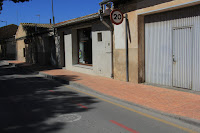Roundabouts in Spain are a bit of a growth industry. New ones pop up all the time. Spanish roundabouts have, to British schooled drivers, strange rules. Basically the outside lane, the one that involves going the greatest distance, always has precedence. So, whereas in the UK you use a different entry lane for right as against left turns there is absolutely no reason to do so in Spain. This isn't particularly important where there is no traffic but it certainly makes big and busy roundabouts in cities quite interesting. As well as the priorities being different the only necessary turn signal is one to show that you are leaving the roundabout. That British thing of signalling to show you're staying in the roundabout and then changing turn signals to show you're leaving is not the Spanish way. And, as most Spanish drivers seem to have forgotten where they put the turn signal controls that leads to even extra fun in roundabouts.
When we got here to Pinoso, if my memory serves me well, there were six roundabouts within the Pinoso boundary. We now have nine. The three extra ones have all been built since 2018. Prettifying the roundabouts seems to be quite important. One of the Pinoso ones has a huge thing built out of blocks of local marble - I've heard it called The Coliseum and Stonehenge. Outside Abanilla they have one with artificial grass and with a replica of the big stone Archbishop's Cross that they have atop their local mountain. The one by the Dos Mares Shopping centre in San Javier has a jet trainer. At la Romana there are twin marble towers. There are others with really old olive trees, with fishing boats, with wine barrels and sculptures. I often wonder about the one out at Salado Alto which is sown with lots of stones that look like the standing stones at Carnac. I'm sure some bewildered 29th Century archaeologist will fall back on the old chestnut of religious significance to explain them. Of course the maintenance of the roundabouts can be a bit hit and miss. Weeds adorn more than their fair share.
Two of the older roundabouts in Pinoso have been getting a bit of a facelift recently. The one at the entrance to Pinoso, from Monóvar on the CV83, now boasts and awful lot of concrete. The remodelling though has left the three pine trees, similar to the ones which feature on the town's coat of arms, in place. The masonry sign embellished with the town coat of arms is still there to show why the roundabout is as it is.
The other roundabout, the one where the CV836 comes in from Yecla or, if you prefer, the one where the CV83, as an extension of the RM427, comes in from Jumilla, has also been getting a facelift. There they have coloured and contoured the concrete. I'm sure you know, but, just in case you don't, the roads with the CV prefix belong to the Comunitat Valenciana whilst the ones that begin RM are in the Región de Murcia. In the same vein if it were a national road it would have an N designation, or maybe an A for Autovía or motorway.
I had wondered about all that concrete. Before the titivation the roundabouts were mainly soil and gravel. It's not exactly that we're short of greenery round here but it did seem slightly perverse to lay tons and tons of concrete in what are supposed to be environmentally aware times. In that way that things have of co-inciding, of happenstance, I was listening to an interview on the radio and they got to talking about roundabouts. The group being interviewed were an action group that is trying to replant trees and bushes all over Spain, their name is Arriba las ramas or something like Up with branches! Their spokesperson said that a trend in several cities was to plant roundabouts with native species. Trees, bushes and plants that can look after themselves without the need for costly maintenance. The provision of a habitat for local beasts was a bit of a side benefit. Obviously that's not a trend around here.
I'd mentioned the concrete to Maggie as we drove past. I wondered about the rain. When it rains around here it often rains in shedloads. With the gravel and soil on the roundabouts the water had somewhere to escape to. I can envisage that same rain cascading off the concrete into the roadway. Mind you, if they have architects for roundabouts I suppose they know about drains too!
The photos are of three of our Pinoso roundabouts.






